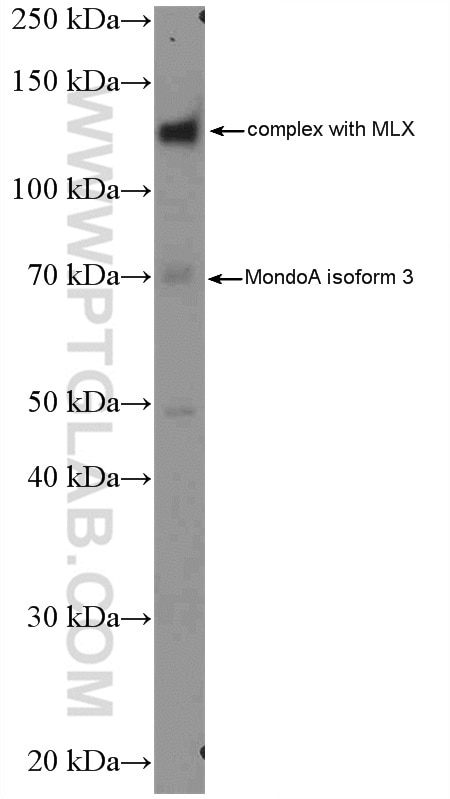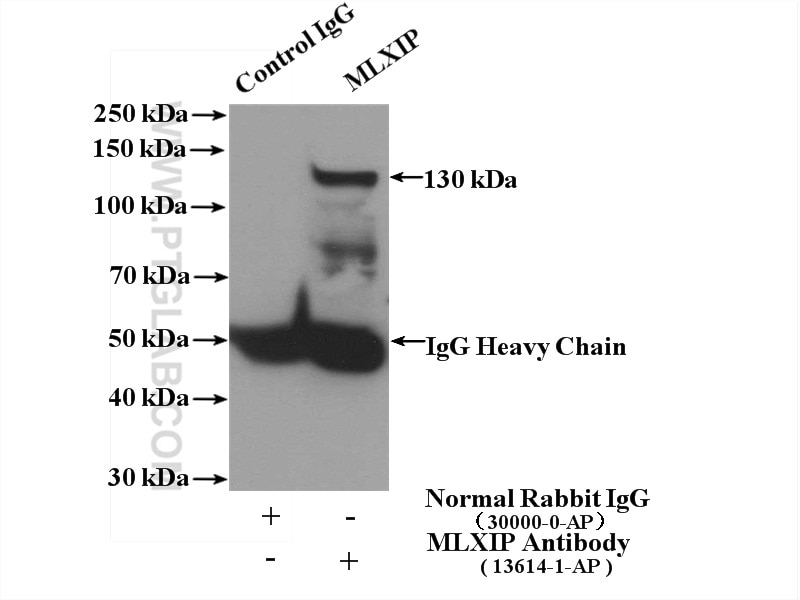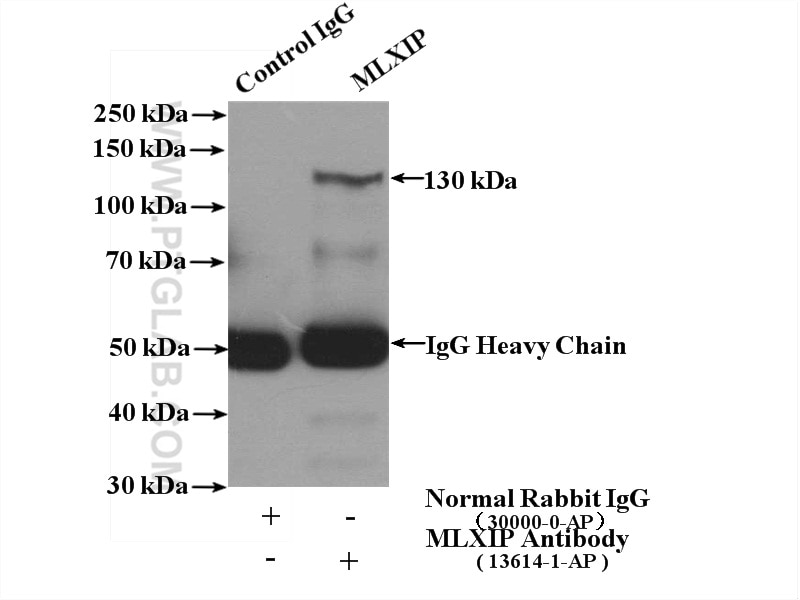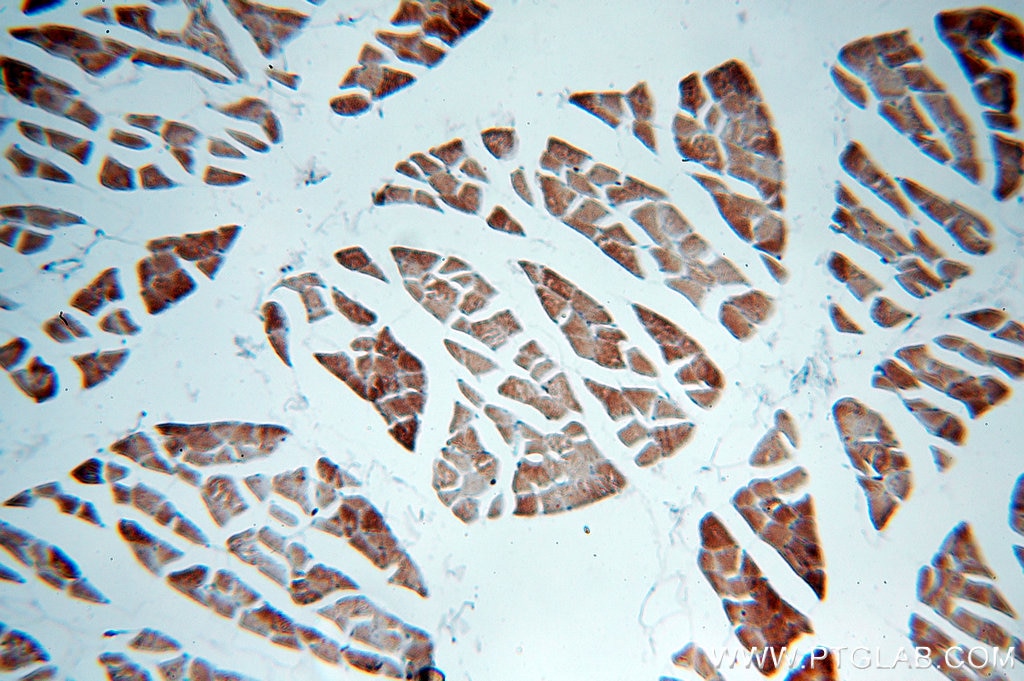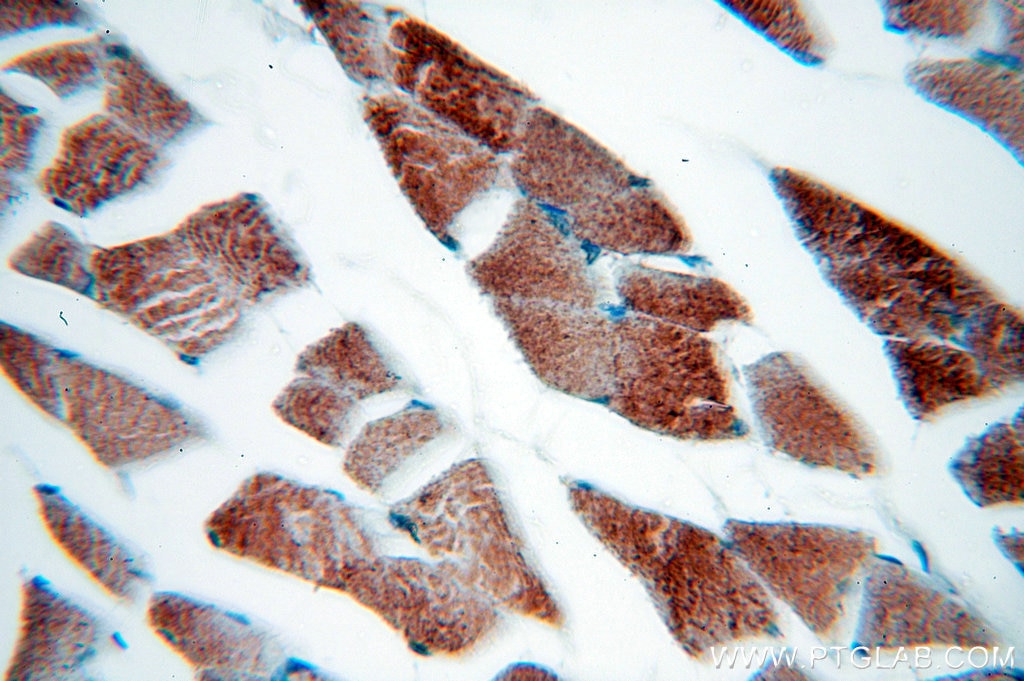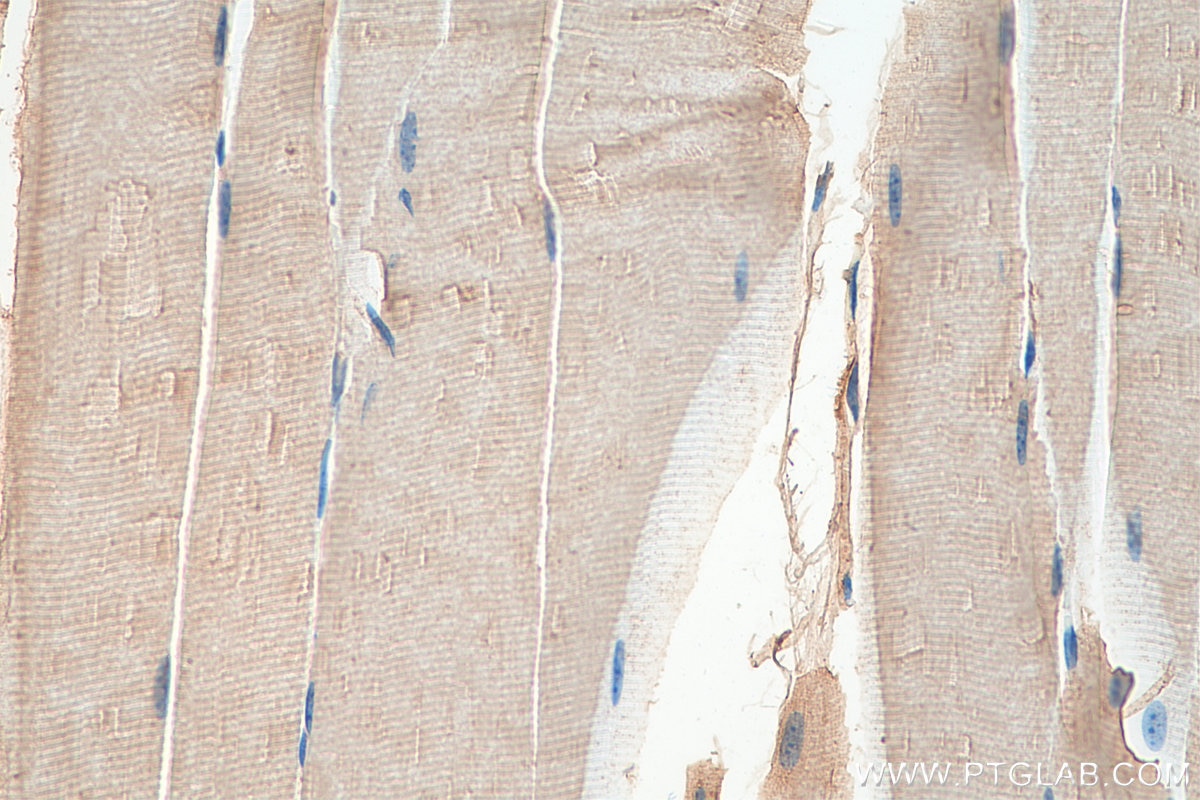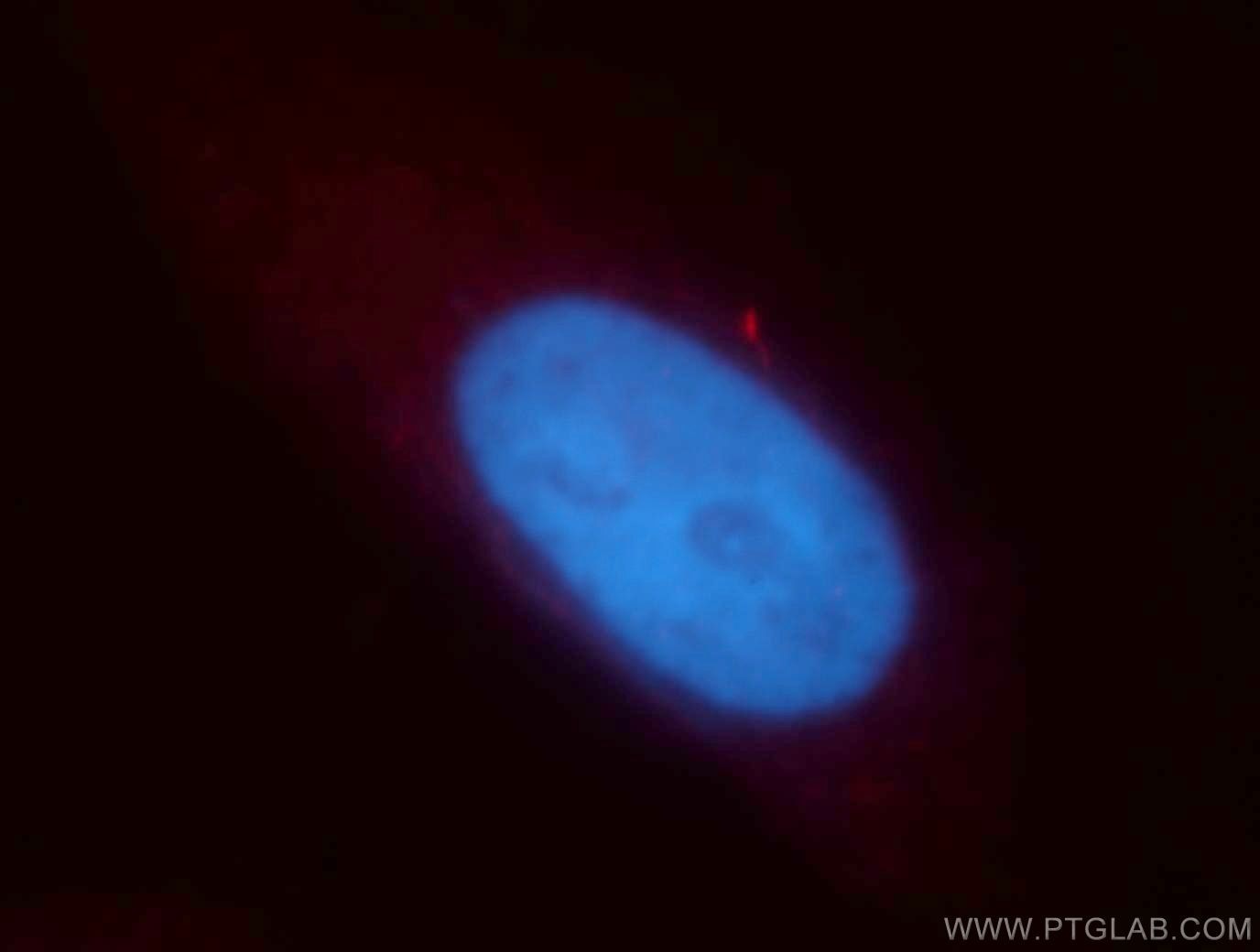- Featured Product
- KD/KO Validated
MLXIP Polyklonaler Antikörper
MLXIP Polyklonal Antikörper für WB, IHC, IF/ICC, IP, ELISA
Wirt / Isotyp
Kaninchen / IgG
Getestete Reaktivität
human, Maus, Ratte
Anwendung
WB, IHC, IF/ICC, IP, ChIP, ELISA
Konjugation
Unkonjugiert
Kat-Nr. : 13614-1-AP
Synonyme
Galerie der Validierungsdaten
Geprüfte Anwendungen
| Erfolgreiche Detektion in WB | K-562-Zellen |
| Erfolgreiche IP | K-562-Zellen |
| Erfolgreiche Detektion in IHC | humanes Skelettmuskelgewebe, Maus-Skelettmuskelgewebe Hinweis: Antigendemaskierung mit TE-Puffer pH 9,0 empfohlen. (*) Wahlweise kann die Antigendemaskierung auch mit Citratpuffer pH 6,0 erfolgen. |
| Erfolgreiche Detektion in IF/ICC | HepG2-Zellen |
Empfohlene Verdünnung
| Anwendung | Verdünnung |
|---|---|
| Western Blot (WB) | WB : 1:200-1:1000 |
| Immunpräzipitation (IP) | IP : 0.5-4.0 ug for 1.0-3.0 mg of total protein lysate |
| Immunhistochemie (IHC) | IHC : 1:20-1:200 |
| Immunfluoreszenz (IF)/ICC | IF/ICC : 1:10-1:100 |
| It is recommended that this reagent should be titrated in each testing system to obtain optimal results. | |
| Sample-dependent, check data in validation data gallery | |
Veröffentlichte Anwendungen
| KD/KO | See 4 publications below |
| WB | See 10 publications below |
| IHC | See 2 publications below |
| IF | See 1 publications below |
| IP | See 3 publications below |
| FC | See 1 publications below |
| ChIP | See 5 publications below |
Produktinformation
13614-1-AP bindet in WB, IHC, IF/ICC, IP, ChIP, ELISA MLXIP und zeigt Reaktivität mit human, Maus, Ratten
| Getestete Reaktivität | human, Maus, Ratte |
| In Publikationen genannte Reaktivität | human, Maus, Ratte |
| Wirt / Isotyp | Kaninchen / IgG |
| Klonalität | Polyklonal |
| Typ | Antikörper |
| Immunogen | MLXIP fusion protein Ag4519 |
| Vollständiger Name | MLX interacting protein |
| Berechnetes Molekulargewicht | 919 aa, 100 kDa |
| Beobachtetes Molekulargewicht | 130 kDa |
| GenBank-Zugangsnummer | BC039704 |
| Gene symbol | MLXIP |
| Gene ID (NCBI) | 22877 |
| Konjugation | Unkonjugiert |
| Form | Liquid |
| Reinigungsmethode | Antigen-Affinitätsreinigung |
| Lagerungspuffer | PBS mit 0.02% Natriumazid und 50% Glycerin pH 7.3. |
| Lagerungsbedingungen | Bei -20°C lagern. Nach dem Versand ein Jahr lang stabil Aliquotieren ist bei -20oC Lagerung nicht notwendig. 20ul Größen enthalten 0,1% BSA. |
Hintergrundinformationen
Mlx-interacting protein(MLXIP), after forming heterodimers with MLX, can bind to and then activate transcription from CACGTG E boxes. The N terminus of MLXIP acts as a CRM1-dependent nuclear export signal and contribute to the cytoplasmic localization of the complex, and as a binding site for 13 protein. the C terminus contains a cytoplasmic localization signal and mediates protein-protein interaction of MONDOA and MLX. The complex play a role in transcriptional activation of glycolytic target genes and glucose-responsive gene regulation. This antibody could recognize isoform1(~110kd) and isoform3(~69kd) of MLXIP. A prominent and specific MLXIP of approximately 130 kDa was detected. It demonstrates that MLXIP associated specifically with Mlx in the cytoplasm (PMID: 11073985).
Protokolle
| Produktspezifische Protokolle | |
|---|---|
| WB protocol for MLXIP antibody 13614-1-AP | Protokoll herunterladen |
| IHC protocol for MLXIP antibody 13614-1-AP | Protokoll herunterladen |
| IF protocol for MLXIP antibody 13614-1-AP | Protokoll herunterladen |
| IP protocol for MLXIP antibody 13614-1-AP | Protokoll herunterladen |
| Standard-Protokolle | |
|---|---|
| Klicken Sie hier, um unsere Standardprotokolle anzuzeigen |
Publikationen
| Species | Application | Title |
|---|---|---|
Cancer Cell Deregulated Myc requires MondoA/Mlx for metabolic reprogramming and tumorigenesis. | ||
Gastroenterology MondoA-Thioredoxin-Interacting Protein Axis Maintains Regulatory T-Cell Identity and Function in Colorectal Cancer Microenvironment. | ||
Proc Natl Acad Sci U S A Metabolic reprogramming in triple-negative breast cancer through Myc suppression of TXNIP. | ||
Diabetes MondoA is an Essential Glucose Responsive Transcription Factor in Human Pancreatic Beta Cells. | ||
PLoS Pathog Latent KSHV Infected Endothelial Cells Are Glutamine Addicted and Require Glutaminolysis for Survival. |
